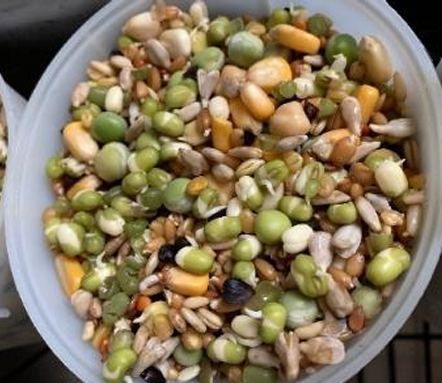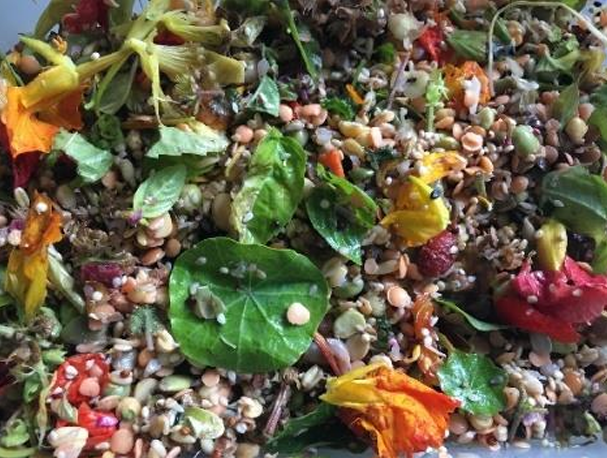Parrot Nutrition: Easy meal planning – Dr. Jason Crean
MORNINGS – Fresh Food Feeding: All parrots, regardless of species or size, must have fresh, whole food daily in the form of fruits, vegetables, sprouts and more. Birds should only have dry foods after they have consumed fresh foods earlier in the day. Dry food should be removed at bedtime so the first food your bird sees is the fresh food feeding described here. Making a mash that can be stored in an airtight container in the refrigerator (or frozen for less than 2 months at a time) is best. Your mash should contain the following:
- 10-15% Soaked items (soaked 8-12 hours) including some seeds, shelled nuts, lentils, split peas, etc.
- 10-20% Sprouted items (see below for directions) including sunflower and other seeds, legumes, and grains.
- 30-40% Vegetables (diced, shredded, or chunked according to the size of your bird) including leafy greens, squashes, peppers, and more.
- 10-15% Fruits are NOT added to the mash to avoid excess moisture but are fed daily as well in addition to the mash.
- 10-15% dry matter like dried greens and/or flowers, dry grains, and other items that will absorb excess moisture.
There are a few easy steps to creating a whole food mash, rich in living foods. First, let’s look at sprouting:
Step 1: Rinse – Rinse the dry items in cool, clean water.
Step 2: Soak – Completely submerge all items in cool, clean water for 10-12 hours.
Step 3: Sprout – During the sprouting process, drain and rinse the sprouts 2-3 times daily.

Submerge the sprouts in a solution of the GSE stabilizer after each rinse, leaving this solution on the sprouts until the next rinse. When you see the small root tails emerging, do a final rinse and add to your mash. If you have a sprouting mix specifically for birds, you can sprout for 12 24 hours, rinsing once or twice during that time. This means after a 12-hour soak and a 12-hour sprout time, you can have sprouts ready to feed after only 24 hours. Note: Some items need only be soaked overnight like those in the Thrive! product or soaked shelled nuts. Whether the item can be fed just soaked or sprouted, always rinse well before adding to mash.

Step 4: Make your Mash
In a large bowl, mix the sprouts together, putting the Biodiversity Bird Blends Green Forage in first, followed by the sprouts and chopped fresh greens and other
vegetables.
Want some suggestions for produce? Kale, collard and mustard greens, dandelion greens, carrots (with tops), peppers, red cabbage, pea pods, Brussels sprouts,
broccoli, and/or grow some microgreens that you can grow yourself (like those from biobirdblends.com). There really is not much you can’t include but choose items that aren’t as likely to wilt or become soggy.
Step 5: Feed
Offer enough that they will consume within a few hours and feel free to vary the fresh additions you offer in the way of fresh vegetables, edible flowers, etc.

LATE AFTERNOON/EVENING – Dry Feeding: After you pull what’s left of their morning feeding, you can offer a dry mix of foods to round out their nutrient requirements. This will include dry seeds and grains, freeze dried vegetables and fruits, TOPs brand organic parrot pellets, dried flowers, and even freeze-dried mealworms. You can get a bundle box with all these dry components from biobirdblends.com and it will be shipped right to your door. The Best of Both Bird Bundle Box gives you what you need to make the fresh food mash above and the dry mix you see at the right. More info at Avian Raw Whole Food Nutrition group on Facebook.
